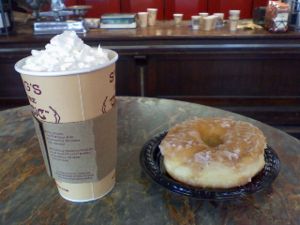Coffee: Difference between revisions
imported>Robert W King No edit summary |
imported>Robert W King No edit summary |
||
| Line 6: | Line 6: | ||
Coffee can be served in a number of ways. The most traditional method is by which the beans are ground, and then placed into a paper filter, where hot water is then strained into the filter, soaking the grounds, and then into a coffee pot. The appliances that produce coffee in this way are known as drip-style coffee makers, or "drip-pots". | Coffee can be served in a number of ways. The most traditional method is by which the beans are ground, and then placed into a paper filter, where hot water is then strained into the filter, soaking the grounds, and then into a coffee pot. The appliances that produce coffee in this way are known as drip-style coffee makers, or "drip-pots". | ||
A popular, european style of producing coffee is to grind espresso beans and compress them into a filter. Hot water is then compressed into the filter, producing a concentrated form of coffee that has a very dark color and high caffeine content. This is known simply as espresso, and is often served in quantites of ounces, or "shots". These espresso machines can create pressure by either heating water up to its boiling point, creating steam | A popular, european style of producing coffee is to grind espresso beans and compress them into a filter. Hot water is then compressed into the filter, producing a concentrated form of coffee that has a very dark color and high caffeine content. This is known simply as espresso, and is often served in quantites of ounces, or "shots". These espresso machines can create pressure by either heating water up to its boiling point, creating steam to produce the concentrate, or through a pump that injects water into the compressed grounds. The amount of compression (measured in pounds/square inch (psi)) varies between the different styles of appliances. | ||
Revision as of 10:05, 15 June 2007
Coffee, brewed from beans, is a popular drink across the entire world. Coffee beans are harvested from cherries grown from the genus of plants known as Coffea. There are over 500 genera and 6,000 species of tropical coffea trees.
A coffee cherry's outer skin is the exocarp, beneath it a thin layer of pulp known as mesocarp, then a slimy layer called parenchyma. The beans within this are covered in a thin layer named the endocarp. Inside the endocarp are two beans, usually positioned next to each other, divided by a membrane called the spermoderm.
Coffee can be served in a number of ways. The most traditional method is by which the beans are ground, and then placed into a paper filter, where hot water is then strained into the filter, soaking the grounds, and then into a coffee pot. The appliances that produce coffee in this way are known as drip-style coffee makers, or "drip-pots".
A popular, european style of producing coffee is to grind espresso beans and compress them into a filter. Hot water is then compressed into the filter, producing a concentrated form of coffee that has a very dark color and high caffeine content. This is known simply as espresso, and is often served in quantites of ounces, or "shots". These espresso machines can create pressure by either heating water up to its boiling point, creating steam to produce the concentrate, or through a pump that injects water into the compressed grounds. The amount of compression (measured in pounds/square inch (psi)) varies between the different styles of appliances.
